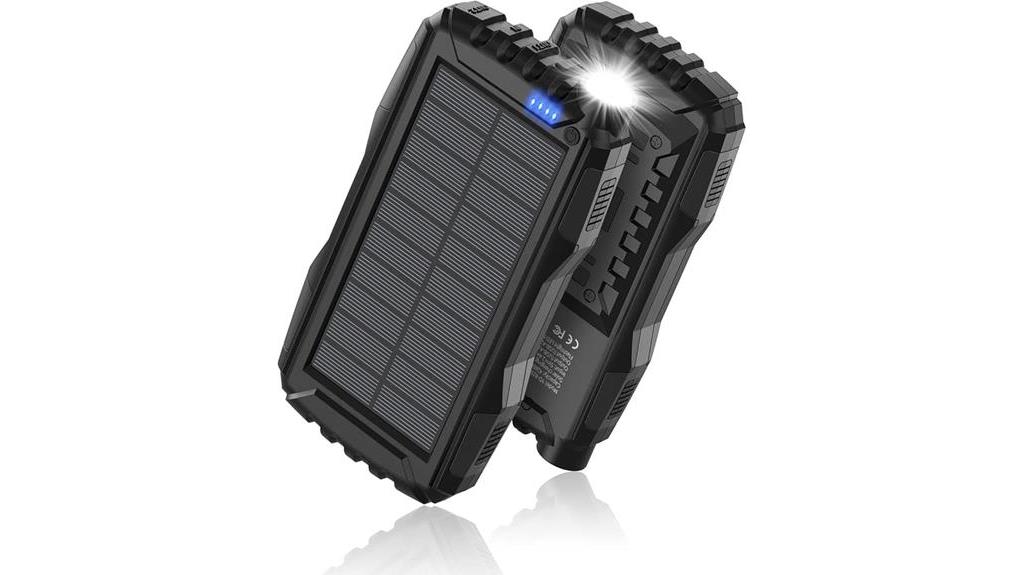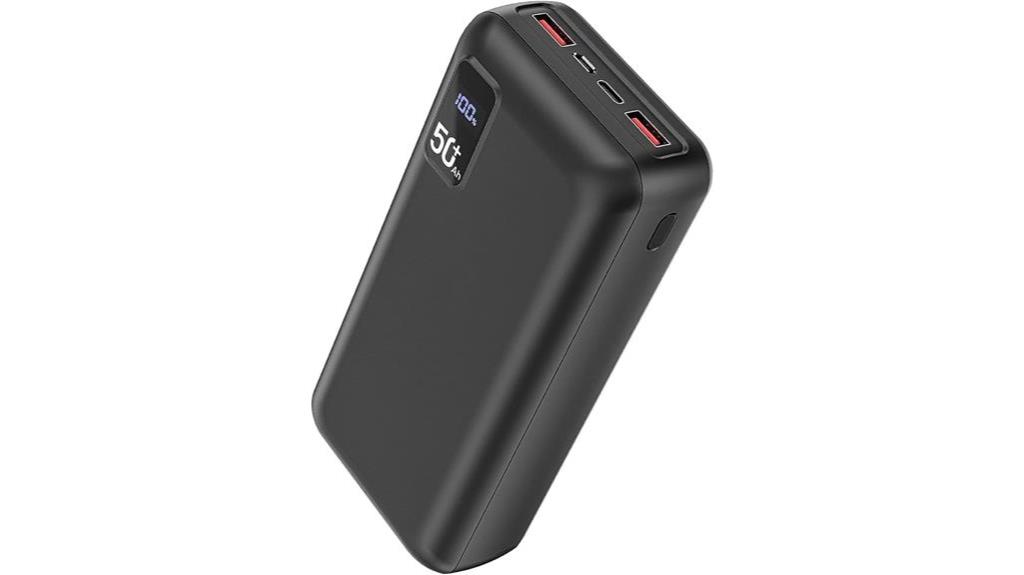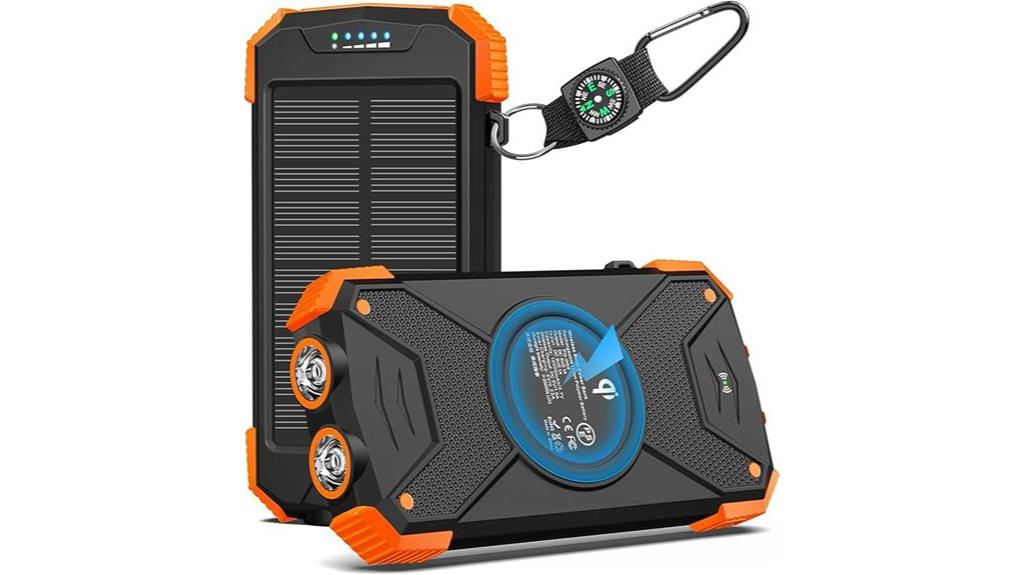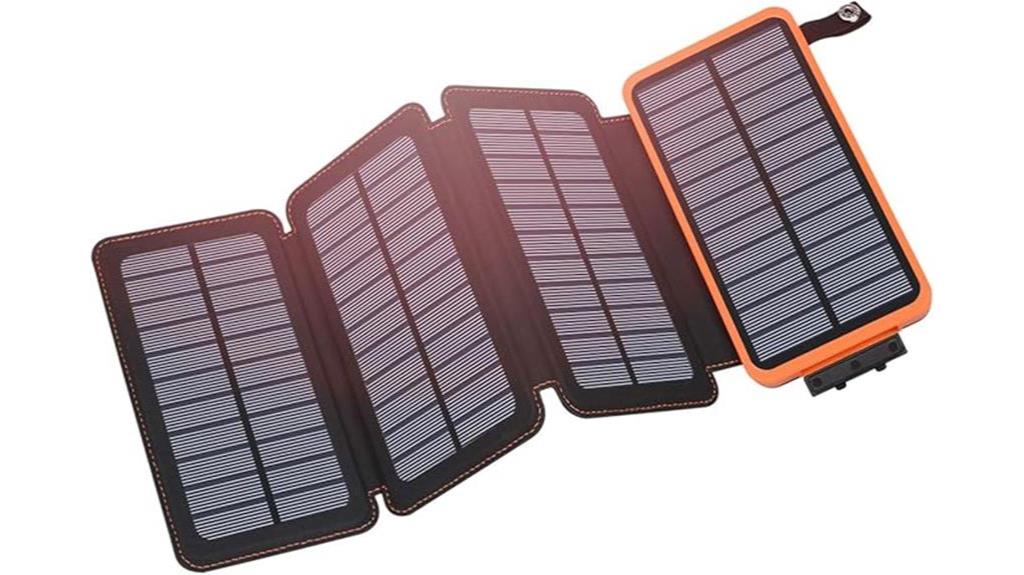For your outdoor adventures in 2024, you'll want the best backpacking battery banks that blend power with portability. Consider the Power Bank Solar Charger (42,800mAh) for multiple charges and rugged durability. The VEEKTOMX Mini Power Bank (10,000mAh) is lightweight and fast-charging, perfect for on-the-go. If you need massive capacity, the 50,000mAh option won't disappoint. The BLAVOR Solar Charger (10,000mAh) and Hiluckey Solar Charger (25,000mAh) both offer solar capabilities, ideal for sunny days. Each option guarantees you stay connected, and the details get even better from here.
Power Bank Solar Charger 42800mAh Portable Charger

If you're an outdoor enthusiast or a camper, the Power Bank Solar Charger 42800mAh Portable Charger is a game-changer for your adventures. With its massive capacity, I can charge my smartphone up to six times, making it perfect for extended trips. The dual USB ports and QC3.0 fast charge protocol keep all my devices powered up quickly. I love how it's built from durable ABS material and is IP67 waterproof, so I don't worry about it getting damaged in harsh conditions. The built-in flashlight is a bonus during nighttime outings. Just remember, while the solar charging feature is handy in emergencies, I wouldn't rely on it solely. Overall, it's an essential tool for any serious backpacker like me.
Best For: Outdoor enthusiasts, campers, and anyone needing reliable backup power during adventures.
Pros:
- Durable construction with IP67 rating ensures protection against water, dust, and drops.
- Massive 42800mAh capacity allows charging a smartphone up to six times, perfect for extended use.
- Dual USB output ports with QC3.0 fast charge support for quick charging of multiple devices.
Cons:
- Solar charging is slow and not suitable as a primary charging method, best used as a backup.
- Bulky design compared to non-solar power banks may be less convenient for some users.
- Limited solar panel functionality means recharging via solar takes a significant amount of time.
VEEKTOMX Mini Power Bank 10000mAh with Fast Charging

The VEEKTOMX Mini Power Bank 10,000mAh with Fast Charging is an exceptional choice for anyone who frequently travels or enjoys outdoor adventures. Its compact design makes it easy to slip into my pocket or bag, weighing just 5.8 ounces. With dual PD 3.0 and QC 3.0 technologies, it charges my devices up to twice as fast as standard chargers, getting my iPhone 15 or Samsung S24 to 45% in just 30 minutes. The dual USB-A and USB-C ports guarantee compatibility with a range of devices, while the advanced safety features provide peace of mind. The digital LED display keeps me informed about the battery level, making this power bank reliable for all my charging needs.
Best For: Travelers and outdoor enthusiasts seeking a compact and efficient charging solution for their devices.
Pros:
- Fast charging capabilities with dual PD 3.0 and QC 3.0 technologies, significantly reducing charging time.
- Compact and lightweight design allows for easy portability in pockets, wallets, or handbags.
- Advanced safety features ensure protection against overcurrent, overheating, and overcharging.
Cons:
- Some users report minor issues with the fit of the USB-C port, which may affect connectivity.
- Limited capacity of 10,000mAh may not be sufficient for users with multiple high-capacity devices.
- No built-in cables, requiring separate charging cables for use.
Power Bank 50000mAh Fast Charging Portable Charger

For outdoor enthusiasts and travelers needing reliable power on the go, the POIYTL Power Bank 50000mAh is an exceptional choice. With a massive capacity, it can charge my iPhone 11 up to ten times, which is perfect for long camping trips or hikes. The 22.5W fast charging capability is a game-changer; I can get my iPhone X to 60% in just 30 minutes. Plus, the multiple outputs let me charge up to three devices simultaneously, keeping all my essentials powered. I appreciate the built-in safety features that prevent overcharging and short circuits. Although it's a bit bulky for daily use, its durability and smart digital display make it a reliable companion for any adventure.
Best For: Outdoor enthusiasts and travelers who need a reliable and high-capacity power source for their devices.
Pros:
- Fast charging capability with 22.5W USB-C port, allowing for quick power boosts.
- Large 50000mAh capacity provides multiple charges for smartphones, ideal for extended trips.
- Built-in safety features ensure protection against overcharging, short circuits, and temperature issues.
Cons:
- Bulky design may be inconvenient for everyday carry.
- Not allowed on commercial flights due to its size and capacity.
- Some users may find it heavier compared to smaller power banks.
BLAVOR Solar Charger Power Bank 10,000mAh

Are you an outdoor enthusiast looking for a reliable power source during your adventures? The BLAVOR Solar Charger Power Bank is a game-changer with its 10,000mAh capacity. It's compact and lightweight, easily fitting into your backpack. I love that it supports USB-C and can charge three devices at once, making it perfect for all my gadgets. The 20W fast charging really impresses me, too—my iPhone 15 gets to 65% in just 30 minutes.
Its solar charging feature is handy for longer trips, though it might take a few days to fully charge in direct sunlight. Plus, it's waterproof and shockproof, which is essential for outdoor use. For anyone needing a dependable backup charger, this power bank is definitely worth considering!
Best For: Outdoor enthusiasts and travelers looking for a portable and reliable backup power source.
Pros:
- 20W fast charging capability charges devices quickly, making it convenient for on-the-go use.
- Compact and lightweight design allows for easy portability in backpacks or bags.
- Durable construction with IPX5 waterproof and shockproof features, ideal for outdoor conditions.
Cons:
- Solar charging can be slow, taking up to three days for a full charge under optimal conditions.
- Wireless charging may not work with all devices, especially those with thick cases.
- Limited charging capacity of 10,000mAh may not be sufficient for extensive power needs.
Hiluckey Solar Charger 25000mAh with 4 Solar Panels

Looking for a reliable power source during your outdoor adventures? The Hiluckey Solar Charger with a 25000mAh capacity might be just what you need. With the ability to charge your smartphone 6-8 times and tablets 2.5 times, it's perfect for long trips. Its four solar panels provide a 6W output in direct sunlight, allowing you to harness energy on the go. Plus, the 15W fast charging means you can get an iPhone to 50% in just 30 minutes. I appreciate the built-in flashlight for emergencies and its compact design, which easily attaches to my backpack. Just keep in mind that solar charging can take a while, so plan accordingly. Overall, it's a solid choice for outdoor enthusiasts.
Best For: Outdoor enthusiasts and travelers who need a reliable power source for multiple devices during extended trips without access to electricity.
Pros:
- High capacity: 25000mAh allows for multiple charges of smartphones and tablets.
- Fast charging: 15W output enables quick charging of devices, including iPhones.
- Portable design: Compact and easy to attach to backpacks, making it convenient for outdoor activities.
Cons:
- Slow solar charging: Can take up to 50 hours to fully charge via solar panels, depending on conditions.
- Weight and bulkiness: Higher capacity may result in a heavier and bulkier design.
- Maintenance needed: Users must avoid full discharge and recharge every three months for optimal performance.
Factors to Consider When Choosing Backpacking Battery Banks
When choosing a backpacking battery bank, you'll want to reflect on several key factors. Capacity and size matter for how much power you can store, while charging speed options can impact how quickly you can recharge your devices. Don't forget to take into account durability, portability, and solar charging efficiency to guarantee you pick the best option for your adventures.
Capacity and Size
Capacity and size play a critical role in selecting the right backpacking battery bank for your adventures. When you're on the go, it's essential to choose a battery bank with sufficient capacity, typically measured in mAh. Aim for options between 10,000mAh to 50,000mAh, as these can provide multiple charges for your devices, ensuring you won't run out of power during your trip.
A compact design is equally important. Look for lightweight battery banks that easily fit into your pockets or bags without adding significant bulk. This will keep your pack manageable while ensuring you have the power you need.
Durability is another key factor. Opt for battery banks made from robust materials with features like waterproofing (an IP67 rating is ideal) to withstand the rugged conditions of the great outdoors.
Charging Speed Options
Charging speed often makes a significant difference in your backpacking experience, especially when you're on the move. When choosing a battery bank, consider the wattage output. Standard charging at 5W is fine, but fast charging options of 15W to 22.5W can charge your devices much quicker, saving you precious time. Technologies like QC 3.0 and PD 3.0 can juice up compatible devices to 50% in just 30 minutes, perfect for those quick breaks during your hike.
While some battery banks offer solar charging capabilities, keep in mind that this method is typically slower and can take hours or even days, depending on sunlight. If you find yourself in low-light conditions, solar efficiency drops, making it less reliable for primary charging needs.
Also, think about the number of output ports available. Having multiple ports means you can charge several devices simultaneously, enhancing your overall charging efficiency—especially useful for group outings. So, prioritize these charging speed options when selecting your backpacking battery bank to guarantee you're always powered up and ready for your next adventure.
Durability and Protection
Choosing a reliable battery bank means considering not just its charging speed but also its durability and protection features. Look for power banks constructed from durable materials like ABS, which are heat and chemical resistant. This guarantees they can withstand the rigors of outdoor conditions. You'll want a power bank with an IP67 rating or higher, ensuring it's waterproof, dust-proof, and drop-proof—ideal for extreme environments.
Additionally, opt for power banks that boast a high number of charging cycles, ideally over 1600. This will guarantee your bank remains reliable and long-lasting during extended trips. While it's important to focus on durability, also consider compact and lightweight designs. These will ease portability without sacrificing battery capacity for multiple charges.
Portability and Weight
When you're out on the trail, the portability and weight of your battery bank can make or break your backpacking experience. You'll want to find a battery bank that strikes a balance between capacity and weight. Higher capacity models often come with added bulk, which can become a burden during long hikes. Aim for compact designs, like those around 4.2 x 2.7 x 0.6 inches and weighing about 5.8 ounces, as they easily fit into pockets or small compartments in your backpack.
Look for battery banks with higher mAh ratings, such as 25,000mAh and above, while still being lightweight. This way, you can guarantee multiple device charges without excessive bulk. Features like built-in clips or straps can enhance portability by allowing you to attach the battery bank to the outside of your pack for quick access and extra internal space.
Always check the dimensions and weight specifications before making a choice. Some power banks may boast large capacities but can be cumbersome, making them less practical for your backpacking needs. Prioritize lightweight options to enjoy your adventure without the extra load.
Solar Charging Efficiency
Solar charging efficiency plays an essential role in deciding which backpacking battery bank to take on your adventure. You need to understand that solar charging is highly dependent on sunlight conditions. If you encounter low light or cloudy weather, the effectiveness of your solar charger will diminish considerably. While most solar chargers can capture some energy, remember that fully recharging your battery bank often takes a long time. In fact, some power banks may take over 50 hours to charge completely via solar panels.
The output capacity of solar panels varies too, with some devices generating up to 6W in direct sunlight. This variation can impact how quickly you can recharge your bank. Keep in mind that solar charging is generally slow and should be viewed as a supplementary method rather than a primary charging source. It's best suited for emergencies when other options aren't available. Finally, be aware that environmental factors, like charging through glass, can limit energy capture, further affecting efficiency. So, when selecting a solar-powered battery bank, weigh these factors carefully to guarantee you stay charged during your outdoor adventures.
Device Compatibility and Ports
A backpacking battery bank needs to be compatible with your devices to confirm you stay powered up on your adventures. Start by verifying your power bank includes multiple ports, like USB-A and USB-C, so you can charge a variety of devices such as smartphones, tablets, and cameras. It's also wise to look for models that support fast charging technologies like QC 3.0 or PD 3.0, allowing quicker recharging and enhancing your overall efficiency during trips.
Consider the number of output ports available; banks with dual or multiple outputs let you charge several devices at once, which is especially useful on group outings. Additionally, check for compatibility with various devices; some power banks might not support wireless charging or may be affected by certain phone cases, limiting functionality.
Opt for models with a USB-C port for both input and output. This simplifies the charging process, as you'll only need a single cable for both the power bank and your devices. By focusing on these factors, you'll confirm that your battery bank meets your needs while you explore the great outdoors.
Frequently Asked Questions
How Do I Know if a Power Bank Is Compatible With My Devices?
To know if a power bank's compatible with your devices, check the output specifications. Look for the voltage and current ratings; they should match your device's requirements. Most smartphones and tablets use 5V, but double-check your device's manual. Also, consider the connectors—make sure the power bank has the right ports, like USB-C or Lightning. Finally, read reviews to see if others have successfully charged similar devices with it.
Can I Bring Battery Banks on Flights?
Yes, you can bring battery banks on flights, but there are a few rules to follow. Most airlines allow power banks in your carry-on luggage, but you shouldn't exceed a certain capacity—usually around 100Wh. Make sure to check with your airline for specific guidelines. It's also a good idea to keep your battery bank easily accessible, since you may need to show it during security checks. Stay informed to avoid any surprises!
What Is the Average Lifespan of a Backpacking Battery Bank?
The average lifespan of a backpacking battery bank typically ranges from 2 to 5 years, depending on usage and care. If you charge and discharge it properly, you'll maximize its longevity. Exposure to extreme temperatures or neglecting to recharge it regularly can shorten its life. To keep your battery bank in good shape, store it in a cool, dry place and avoid letting it drain completely before recharging. You'll enjoy reliable power for your adventures!
How Can I Safely Dispose of a Broken Power Bank?
Did you know that over 300 million lithium-ion batteries, like those in power banks, end up in landfills each year? To safely dispose of a broken power bank, first, check for local electronic recycling programs. Many communities offer drop-off sites. If it's leaking or damaged, place it in a fireproof bag and take it to a hazardous waste facility. Always prioritize safety and environmental responsibility when disposing of such devices.
Are There Any Safety Risks Associated With Using Battery Banks?
Yes, there are safety risks associated with using battery banks. You should always check for damage before use, as a cracked casing can lead to leaks or short circuits. Overloading the battery bank can cause overheating, while using incompatible chargers may result in fires. It's essential to keep your battery bank away from extreme temperatures and moisture. Regularly inspect it for wear and follow manufacturer guidelines to minimize these risks while staying charged.
Wrapping Up
So, as you gear up for your next adventure, remember that staying charged isn't just a luxury; it's a necessity. Who would've thought lugging a power bank would become as essential as packing your trusty hiking boots? Whether you choose a solar charger or a high-capacity option, you're bound to find something that fits your needs. After all, nothing screams "outdoor enthusiast" quite like a fully charged phone—right? Enjoy your trip, and may your devices live long and prosper!
